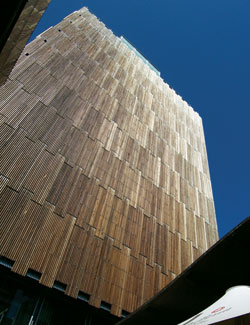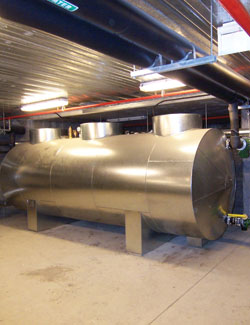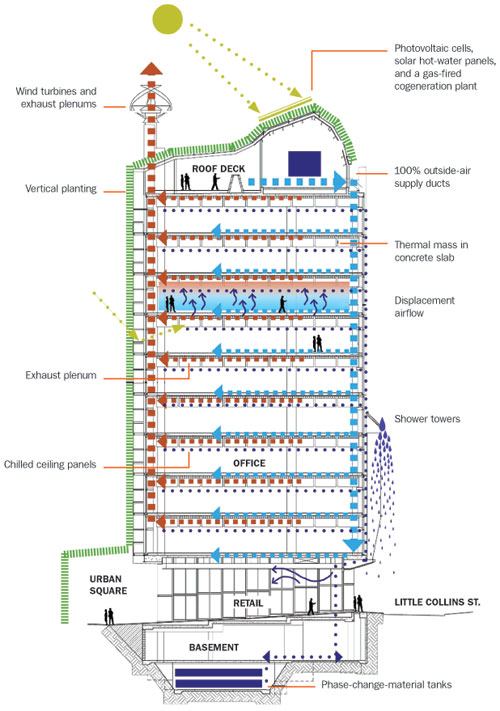Architecture, Hot and Cold
The Nature of Architecture
It's probably safe to say that the average architect doesn't think much about atmospheric pressure cells, let alone competing cells moving counterclockwise that can completely alter a city's weather in the course of half an hour. Melbourne architects complain that, due to such atmospheric conditions, the city experiences all four seasons in one day. DesignInc's Mick Pearce saw opportunities in these circumstances for the design of CH2. Pearce has long adhered to a philosophy of biomimicry, whereby artificial systems−like those in a building−are designed to "mimic" the processes of nature. The biologist Janine Benyus, who Pearce knows well, documented such things in her book Biomimicry: Innovation Inspired by Nature (1997). Pearce implemented the approach with his design for the 1996 Eastgate building in his native Harare, Zimbabwe−a building long-considered a landmark in sustainable design. That naturally ventilated office building relied on basement rock piles as thermal storage for free cooling in a building designed to mimic an African termite mound. "We're beginning to see a whole new science of biological design," says Pearce. "It's much closer to the thinking that goes into a zoo than an office environment." He connected with the CH2 project through his friend, Rob Adams, who, as Melbourne's director of city design and urban environment, is largely credited with championing the high-performance design goals of the building. And thanks to Adams's advocacy, CH2 is the Green Building Council of Australia's first Six Star office building, which is roughly equivalent to LEED Platinum.
|
||||||
With CH2, Pearce and his colleagues at DesignInc sought to implement similar strategies employed at Eastgate, but within the requirements of Australia's version of a Class A office building. "Our climate analysis showed using thermal mass would work well, but Melbourne's pressure cells cause an interval of about three days between hot and cold periods," Pearce says, explaining that rock piles would have needed to be extremely large in order to store heat or cool long enough. "This three-day period is what we exploited with the design. The challenge was to go for serious thermal mass, as well as good thermal storage." From the street, the three most public facades on CH2 actively convey this environmental message: hydraulically controlled recycled timber shutters on the west side automatically open and close depending on the sun's position; balconies with planter boxes on the north shield windows; and the south is defined by fresh-air shafts integrated from the roof down, set behind five so-called "shower towers" that act as exposed cooling towers for the mechanical system.
DesignInc had devised a preliminary scheme that called for tearing down an existing building adjacent to CH2's site, but they scrapped the idea based on the recommendation of the engineers at Lincolne Scott, who were brought in to help rethink the project. Over a three-week charrette in 2003, which included city representatives, architects, and engineers, among other interested parties, the team developed a schematic design incorporating many of the strategies eventually realized in CH2. Ché Wall, managing director of Lincolne Scott and its Advanced Environmental Concepts group, says that "after the charrette, we had 85 percent of the engineering design done." But he adds that the more riskier items were isolated in the design so they could be replaced by conventional strategies in case they failed to perform as expected.












